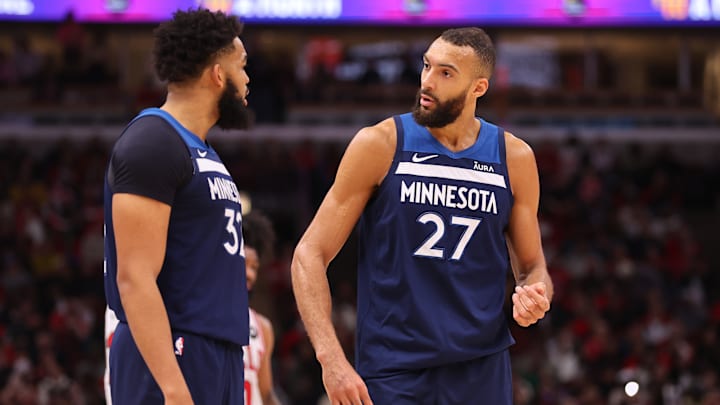Stop me if you've heard this one before, but a dual 7-foot frontcourt doesn't work in today's NBA. Well, if we've learned anything from the Minnesota Timberwolves' success this past season, it actually does. The Timberwolves won 56 games and earned a Western Conference Finals berth for the first time since 2004.
Individually, Gobert won the Defensive Player of the Year award while Towns made the All-Star team and nearly accomplished a 50/40/90 season. Minnesota has one of the best frontcourts in all of basketball. But it isn't sustainable.
Towns is slated to earn $49.3 million next year, and Gobert is set to earn roughly $44 million. The two big men will combine to make up two-thirds of the Timberwolves' cap space. Furthermore, each player will be 30 years old or older by 2025.
Not only will the duo forever be an odd pairing, but their contract situations make for financial inflexibility for years to come. The Wolves will all but likely become a second-apron tax team next season.
Between the six highest-paid players, Minnesota is due to spend $182 million. The second-apron is currently expected to be $182.8 million. As a second-apron team, Minnesota will be unable to utilize any mid-level exception. In the past, mid-level exceptions were granted for all teams above the salary cap to sign free agents for more than the veteran minimum.
In addition to being barred from using mid-level exceptions, second-apron teams cannot combine multiple players' salaries in a trade, they cannot use a prior trade exception, and first-round picks seven years out are frozen. The ramifications are fierce.
Making the case for Gobert
To avoid such consequences, breaking up Minnesota's expensive frontcourt duo is the most obvious answer. Towns has yet to embark on his long-term, gargantuan deal, thus shipping the four-time All-Star out of Minneapolis before next season begins may be the best option.
Towns' value is likely to stand pat, if not decrease in future seasons. He is what he is at this point in his career — and that's a borderline All-NBA talent. What makes assessing Towns' value difficult is his lack of malleability. At seven feet tall, he's best positionally situated at the five. However, his lack of interior defensive presence led the Timberwolves to pair Towns with a generational defensive talent in Gobert.
Towns is by no means a bad defender, he's improved in every season. But he's far from a defensive anchor. Playing Towns at the pivot spot hasn't yielded positive defensive results in the past. Before Gobert arrived in the Twin Cities, Towns' inclusion in the lineup led to opponents scoring more points against Minnesota as opposed to when the veteran big man was on the bench.
Building around a defensive anchor is generally easier than building around an offensive-centric big. Sure, the reigning NBA champion Denver Nuggets' best player is an offensive savant who profiles as an average defender. But Nikola Jokic's offense is just that good. Additionally, the Nuggets have flanked their superstar big man with lanky elite perimeter defensive talent.
To put the Nuggets' theory to rest is simple. The Timberwolves just defeated Denver in the Western Conference Semifinals. On the flip side, an NBA title trumps a Western Conference Finals appearance.
If Towns were to be dealt, adding a mobile, stretch power forward makes the most sense. Think Jaren Jackson Jr., Pascal Siakam, or Lauri Markkanen for instance. All of the aforementioned players can shoot and defend the perimeter—to an extent—while making $10 or more million less than Towns annually.
Making the case for Towns
Previously, it was mentioned that Denver flanked Jokic with above-average defenders. Well, Minnesota has also flanked Towns with some pretty good defensive talent. Anthony Edwards and Jaden McDaniels are great defenders at the two and three-guard spots.
It's quite possible Minnesota feels comfortable with Towns at the five, surrounded by elite perimeter defenders—but lineups with Towns at the pivot haven't yielded the best results on defense. In Minnesota's most played lineup excluding Gobert, and Towns at the five, the Wolves gave up 122 points per 100 possessions—ranking in the 21st percentile. However, this lineup included another offensive-minded player at the four.
Shipping out Gobert instead of Towns would make adding a defensive-minded power forward essential. The 28-year-old big is a quality one-on-one defender, but his help defense leaves much to be desired. Towns isn't the type of player that can rotate and deter shots effectively.
Some intriguing fits next to Towns are Jackson Jr. (again), Herbert Jones, Jonathan Issac, Evan Mobley, Kristaps Porzingis, and Isaiah Hartenstein. The players mentioned prior all possess an attribute that'd pair well with Towns' dynamic offensive game.
Besides the strategy shift, there's also some concern with Gobert's future. Soon to be 32 years old, just how much longer will the French big man be effective? He hasn't shown any signs of declining, but Minnesota will have an extremely difficult decision to make when Gobert nears 35 years old.
The perennial Defensive Player of the Year's contract is up a month before he turns 35 — unless he declines his player option a year prior. Does Minnesota commit an ample amount of money to a player who is closer to 40 than 30? That question is impossible to answer now, but certainly one the front office will ponder over the next few seasons.
Age certainly weighs in Towns' favor as he'll be 33 come the expiration of his contract in 2029. But roster flexibility will seemingly be limited with the offensive star at the five. No matter the best decision, and what the Timberwolves decide to do, it's in their best interest to split this frontcourt up before the salary cap implications become dire.
